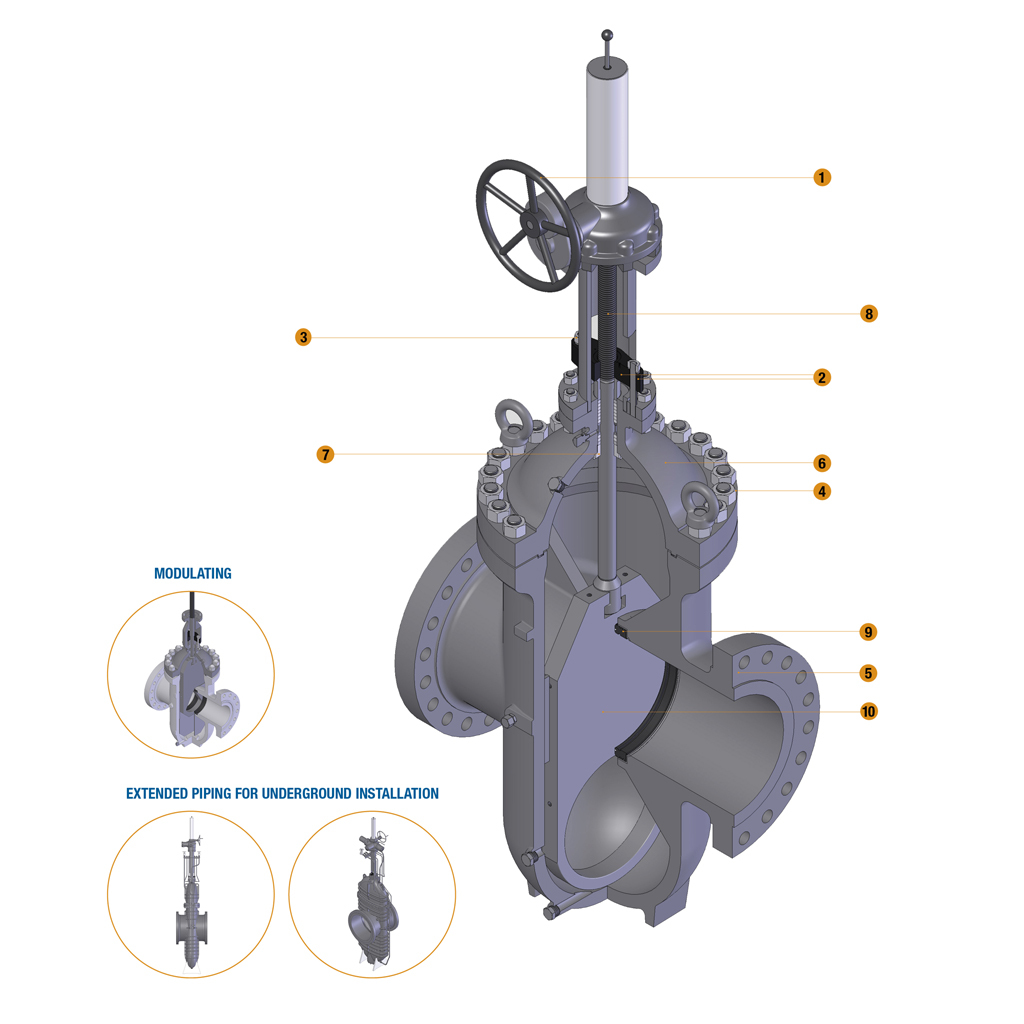GLAND AND FLANGE
They are in forged steel and are supplied in two pieces, self aligning design to permit the gland to descend parallel to the stem even if the eyebolts are unevenly tightened.

A lantern ring can be supplied upon request, in this case the stuffing box shall be drilled, tapped and fitted with an 1/4” NPT plug or grease fitting, for emergency stem sealing. The seats as well can be equipped with seat sealant injectors, with giant buttonhead connection grease fitting. Special actuator /handwheel extension can be arranged in order to lift the actuation position, and as well drain / bleed / injection connections can be extended up to the operator level for underground pipeline application.
Best fit for vertical stem/horizontal flow installation. Special cases can be evaluated and developed on request.
The spoked handwheel is fabricated from steel pipe. The hub is coupled with the yoke sleeve by means of a of a key. Larger valves are equipped with a bevel or spur gear gearbox unit.
They are in forged steel and are supplied in two pieces, self aligning design to permit the gland to descend parallel to the stem even if the eyebolts are unevenly tightened.
The forged steel gland bolts are of the eyebolt type which can be swung outward for ease of gland repacking. They are fixed to the bonnet by hinge pins.
Bonnet studs and nuts are manufactured from alloy steel to the relevant ASTM standard. The body to bonnet connection is designed according to ASME VIII DIV 1 standard.
The body is in carbon or stainless steel and is available in many other CRA. It is carefully designed for total reliability and simple maintenance. The basic dimension, i.e. wall thickness, face to face and flanges comply with the relevant ASME and API standards, in particular the API 6D standard. The body-to-bonnet flange is circular, except for class 150, where an oval flange is used. Standard “through conduit” design allows for passage of scrapers and spheres. The body-to-bonnet joint are flat face on Class 150 valves, male-and-female on Class 300 and 600 and ring joint on Class 900 and above. Bosses are provided for drain taps or by-pass piping. The internal surfaces in contact with the fluid can be fully lined or cladded for improved corrosion or erosion resistance.
As the body, the bonnet is in carbon or stainless steel and is available in many other CRA. It is machined to accept yoke sleeve and incorporates a stuffing box dimensioned in accordance with the API standard. Lifting lugs can be provided integrally cast on the bonnet surface.
The bonnet bushing or backseat is part of the valve trim. Its design allows valve repacking without valve’s bleeding or draining. Hardfacing can be provided on stem seating surface.
The stem is part of the trim and is available in a wide range of material in accordance to API 600 or customer’s requirements. The stem is provided with a T head. A ground backseat is provided to ensure a perfectly tight seal to the stuffing box when the valve is fully open. The stem is highly finished to minimize friction and prevent damage to packing. The threading is trapezoidal ACME type.
The seat rings are floating in their respective pockets in the body. These pockets can be lined to avoid corrosion development on sliding surfaces. The seats are sealing against the body through a lip seal or an O-R. Graphite fire safe gasket can be supplied, in addition to the main gasket. A set of coil springs pushes each seat against the gate and allows the bleeding of any overpressure in the body cavity to the upstream, giving the self relieving capability of the valve, without the need of external relief systems. ORION Slab Gate valves are always double block and bleed type, and is possible to isolate the body cavity from the line in both closed or open position, by bleeding the body cavity.
The slab is part of the trim. It is machined out from plates or forged steel. It is connected to the stem by means of a T- shaped joint. Special care is given to the seating surfaces which are ground and lapped, integral or hardfaced. A cladding or lining can be applied to the larger gates to improve its resistance against erosive and corrosive environments, instead of having those integral in high grades of steel. Seat skirts are installed on valves up to 8” and act both as a gate guide and to limit fluid ingress into the body during open/close operation. Larger sizes can be equipped with skirts as well, but solid sliding guides are holding the gate weight.